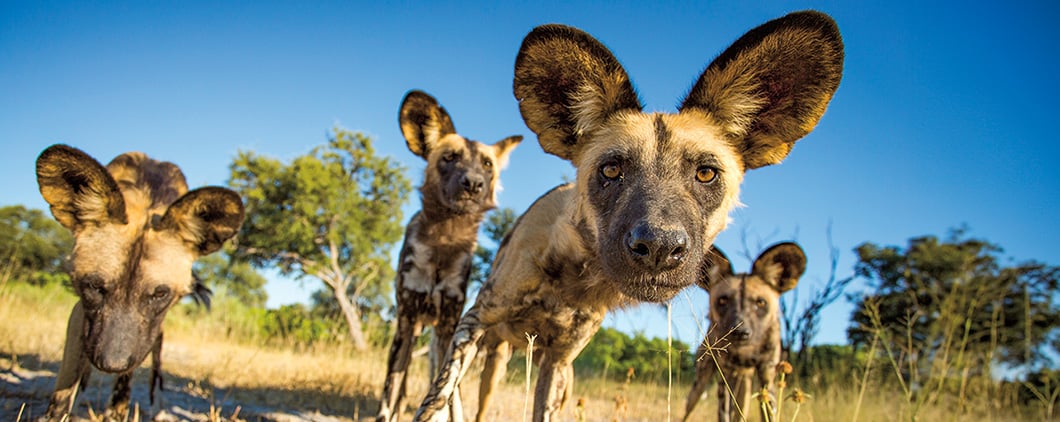This November 5 is Election Day. Millions of Americans will step into voting booths to cast their ballot to choose the next U.S. president as well as state and local officials.
Thousands of miles away, in the grasslands of Botswana, a country in southern Africa, another group is holding a vote to make a decision. But these voters aren’t choosing their next leader. In fact, they’re not even human. They’re African wild dogs, deciding whether the pack should head out to hunt. And some scientists believe they are casting their votes in a surprising way: by sneezing.

Voting in the Wild
Many animals, like these wild dogs, vote on group decisions. Here’s how.
Learning Objective: to read a short informational text, then craft a constructed response that includes a claim, text evidence, and commentary
Standards
Group Decisions
Paul Souders/Getty Images
Achoo!
Many kinds of animals live together in groups and cooperate with one another to survive. Wolves, like African dogs, hunt in packs to take down and kill much larger animals. Gazelles and wildebeests stick together to stay safe from the jaws and claws of lions and other hungry predators. Ants work as a team to dig their underground homes.
Often a group will follow the lead of the biggest and fiercest animal in the pack when it comes time to decide something. But among some species, big decisions—when to hunt, where to live, whether to flee from a predator—are made as a group. Every member, from the youngest to the oldest, has a chance to express its opinion.
A mountain gorilla, for instance, will grunt to express that it wants to move locations. If enough of its fellow troop members grunt too, the whole group moves on. A honeybee will dance to cast its vote for the best spot to build a hive. If enough bees start dancing in front of the same spot, the decision is made.
A Surprising Discovery
Shuttershock
Ready to go?
As for African wild dogs, scientists believed for many years that all decisions were made by pack leaders. Each pack, which usually includes between 5 and 20 animals, is led by a mating pair—a male and a female. Scientists assumed that this pair ruled the group with ruthless authority. For example, only the lead pair’s puppies are allowed to survive into adulthood.
But in 2014, a team of scientists made a surprising discovery. They had traveled to Botswana to learn more about the wild dogs, which are among the most endangered animals on Earth, with only about 6,600 remaining in the wild. The scientists tracked the dogs for weeks. They watched how the packs would gather to play, wrestling and yipping and chasing each other just like your own dog might frolic with its furry pals at the park.
These playful gatherings are called “rallies.” The researchers noticed that in addition to all the fun, there was an unusual amount of sneezing at these rallies. As the dogs ran and jumped, many would also sneeze. Achoos would echo through the air. Then the sneezing fits would suddenly end. The packs would either race off together to hunt for an antelope or a warthog, or stretch out in the grass to laze away the afternoon.
Cooperation and Inspiration
Shuttershock
Let’s live here!
Over time, the scientists started to think that the dogs weren’t really sneezing. As Reena Walker, one of the researchers, told National Geographic, the scientists came to believe that the sneezes acted “as some kind of signal that shapes decision-making.” In other words, the sneezing may have actually been the dogs voting on whether to hunt.
Walker and her colleagues published their findings in 2017. Their goal was to bring more attention to this unique animal. “They’re absolutely gorgeous animals focused on cooperation and their pack family unit,” Walker says.
They can also inspire us humans.
If African dogs can work together to make decisions, we can too.
Short Write
Cooperate means “to work or act together.” How do African wild dogs cooperate?
Answer this question in a well-organized paragraph. Use text evidence.
This article was originally published in the November 2024 issue.
Close Reading, Critical Thinking, Skill Building
1. Prepare to Read
(5 minutes)
Preview Vocabulary (5 minutes)
Project the Google Slides version of Vocabulary: Definitions and Practice on your whiteboard. Review the definitions and complete the activity as a class. Highlighted words: ballot, frolic, laze, ruthless. Audio pronunciations of the words and a read-aloud of the definitions are embedded on the slides. Optionally, print the PDF version or share the slideshow link directly to your LMS and have students preview the words and complete the activity independently before class.
2. Read and Discuss
(20 minutes)
For students’ first read, have them follow along as they listen to the audio read-aloud, located in the Resources tab in Teacher View and at the top of the story page in Student View.
Have students read the story again.
Optionally, divide students into groups to complete the Core Skills Workout: Central Ideas and Details activity. This graphic organizer asks students to identify the central idea and supporting details of each section of the article and the central idea of the article as a whole.
3. Write About It
(20 minutes)
Have students complete the Short Write Kit. This activity can be used to guide students as they write a claim, support it with text evidence, and provide commentary in response to the prompt on page 19 in the printed magazine and at the bottom of the digital story page:
Cooperate means “to work or act together.” How do African wild dogs cooperate? Answer this question in a well-organized paragraph. Use text evidence.
